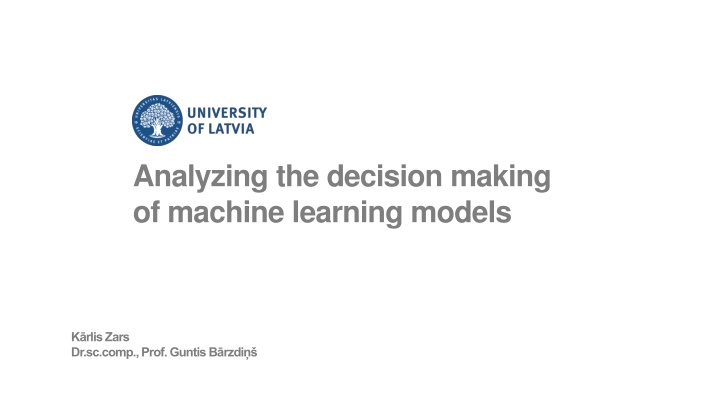
Enhancing Interpretability of Machine Learning Models for Better Decision-Making
Explore the importance of interpreting machine learning models for building trust, ensuring compliance, and preventing biased decisions. Research focuses on developing methods to make complex models transparent and understandable to improve their real-world applications across industries.
Download Presentation

Please find below an Image/Link to download the presentation.
The content on the website is provided AS IS for your information and personal use only. It may not be sold, licensed, or shared on other websites without obtaining consent from the author. If you encounter any issues during the download, it is possible that the publisher has removed the file from their server.
You are allowed to download the files provided on this website for personal or commercial use, subject to the condition that they are used lawfully. All files are the property of their respective owners.
The content on the website is provided AS IS for your information and personal use only. It may not be sold, licensed, or shared on other websites without obtaining consent from the author.
E N D
Presentation Transcript
Analyzing the decision making of machine learning models K rlis Zars Dr.sc.comp., Prof. Guntis B rzdi
Research topic Research focuses on analyzing the decision-making processes of machine learning models. As these models become increasingly complex, understanding their decision- making logic becomes more challenging, yet critically important In various industries, from healthcare to finance, ML models are being used to make high-stakes decisions. However, their black-box nature often leaves decision-makers without clear insights into how these models arrive at their conclusions
Why its important? Interpreting ML models is vital for several reasons: it builds trust in AI systems, ensures compliance with regulatory requirements, and enables humans to understand and justify automated decisions Without a clear understanding of these models, organizations risk making decisions based on potentially flawed or biased logic, which can have significant negative consequences
Research Objectives For now, the primary objective of research is to develop new methods or improve existing ones to enhance the interpretability of black-box machine learning models Specifically, I aim to create techniques that can effectively explain the decision-making processes of complex models, making their outputs more understandable and transparent to non-experts Additionally, my research seeks to promote the use of these interpretability methods in real-world applications, thereby improving the trust and reliability of AI systems across various industries
Overview of Machine Learning Models Machine learning models, from linear regressions to deep neural networks, are tools that learn from data to make predictions or decisions While they vary in complexity, advanced models often operate as black boxes, making their internal decision-making processes opaque Black Box Nature: Complexity leads to non-transparent decision-making
Challenges in Interpreting and Explaining ML Models Complexity and Non-Transparency: The complexity of advanced ML models, especially deep neural networks, makes them difficult to interpret. Non-transparent decision-making processes hinder the ability to understand and trust model outputs. Lack of Interpretability Tools: While there are tools for model interpretation, they often fall short in explaining highly complex models. Existing methods like feature importance scores, partial dependence plots, and surrogate models provide limited insights.
Explainable AI What is XAI? Definition and Importance Benefits of XAI Main Methods of XAI Feature Importance Local Interpretable Model-Agnostic Explanations (LIME) SHapley Additive exPlanations (SHAP) Partial Dependence Plots (PDP) Counterfactual Explanations Applications of XAI Healthcare Finance Autonomous Vehicles Regulatory Compliance
Existing Methods for Model Interpretation Feature Recognition: Feature recognition involves identifying which features (input variables) are most important for the model s predictions. Techniques include feature importance scores, partial dependence plots, and permutation feature importance. Rule Learning: Rule learning methods extract decision rules from models, often presented as if-then statements. Hybrid Models: Hybrid models combine different interpretability methods to leverage their strengths. For instance, using a combination of feature recognition and rule learning to provide comprehensive explanations.
Strengths and Weaknesses of Existing Methods Method Strengths Weaknesses - Provides quantitative measures of feature importance. - Can be applied to a variety of models. - May not capture feature interactions effectively. - Can be computationally intensive for large datasets. Feature Recognition - Produces interpretable rules that are easy to understand. - Useful for validating model decisions. - Limited scalability for complex models. - Rules can become overly complex and less interpretable. Rule Learning - Combines benefits of multiple methods. - Provides comprehensive explanations. - Increased complexity in implementation. - May require more computational resources. Hybrid Models
Existing Methods for Model Interpretation Scalability: Many interpretability methods struggle to scale with the complexity of modern machine learning models, especially deep learning Comprehensiveness: Current methods often focus on specific aspects of interpretability but do not provide a holistic view. Domain-Specific Interpretability: There is a lack of methods tailored to specific industries or applications, which require different interpretability techniques Bias and Fairness: More research is needed to systematically use interpretability methods to ensure fairness and mitigate bias in ML models User-Friendly Tools: Many existing tools are not user-friendly or require significant expertise to use effectively Evaluation Metrics: Standardized metrics for evaluating interpretability methods are needed to compare their effectiveness
Research Objectives and Hypothesis Objectives: Develop new interpretability methods Explain decision-making processes Promote real-world application Hypothesis: Improved interpretability increases trust and adoption Leads to more informed decisions
Proposed Methods Development of New Methods: Design algorithms that provide visual and textual explanations for model predictions, enhancing transparency Create hybrid models that combine interpretable components with advanced ML techniques to balance accuracy and interpretability Improvement of Existing Methods: Enhance current feature recognition techniques to better capture feature interactions and dependencies Refine rule learning algorithms to scale with more complex models while maintaining interpretability
Expected Outcomes Increased Trust and Adoption: By making ML models more interpretable, users will have greater trust in their decisions, leading to wider adoption in various industries Improved Decision-Making: Clear and understandable explanations will enable decision-makers to justify and validate their choices, leading to more informed and reliable decisions Enhanced Ethical and Legal Compliance: Interpretable models will help organizations meet ethical standards and regulatory requirements by providing transparency in automated decision-making processes
Practical Applications Finance: In the finance industry, interpretable models can help in credit scoring and fraud detection by making the decision-making process transparent to both customers and regulators. This transparency can lead to better customer relations and compliance with financial regulations. Legal and Criminal Justice: In legal and criminal justice, interpretable models can assist in risk assessment and sentencing by providing judges with understandable and justifiable recommendations. Ensuring that decisions are transparent can help in maintaining fairness and accountability in the justice system. Marketing: In marketing, understanding customer behavior through interpretable models can enhance targeted advertising and personalization strategies. Clear insights into why a model predicts certain customer preferences can improve campaign effectiveness and customer satisfaction.
Long-term Benefits of Improved ML Model Understanding Increased Trust and Adoption: As models become more interpretable, trust in AI systems will increase, leading to broader adoption across various sectors. This trust is crucial for integrating AI into high-stakes decision-making processes. Enhanced Decision-Making: With clearer insights into model decisions, organizations can make more informed and reliable decisions. This leads to better outcomes in critical areas such as patient care, financial stability, and legal judgments. Ethical and Regulatory Compliance: Interpretable models help meet ethical standards and comply with regulatory requirements by providing transparency in automated decisions. This compliance is essential in maintaining public trust and avoiding legal repercussions. Innovation and Advancement: Improved understanding of ML models can drive innovation, as clearer insights facilitate the development of new and improved AI technologies. This advancement can lead to AI systems that are not only powerful but also aligned with human values and societal needs.
Next Steps Continue developing and refining new interpretability methods, focusing on enhancing transparency and usability Conduct extensive experiments to evaluate the effectiveness of these methods across different types of machine learning models and datasets Publish findings in academic journals and present at conferences to contribute to the broader research community and foster further advancements in the field
Thank you for your attention






















